Brassicas (Brassicaceae) – Family
Bok choy, Broccoli, Brussels sprouts, Cabbage, Cauliflower, Collard, Kale, Kohlrabi, Rutabaga, Turnip
Brassicas are a group of popular vegetables including bok (pak) choy, broccoli, Brussels sprouts, cabbage, cauliflower, collard, kale, kohlrabi, rutabaga and turnip. Chinese cabbage, brown mustard, rape and radishes are also members of the B. oleracea family. Commonly called “cole” crops because of the stems and stalks associated with members of this family, brassicas can be found in products from condiments to salad greens. They are cool weather (60-65°F) plants that do not tolerate high temperatures. All have similar growing requirements, insect pests and diseases. Nutritionally they provide Vitamins A, C, folate, and the minerals calcium, potassium, and iron. They are also a source of fiber.
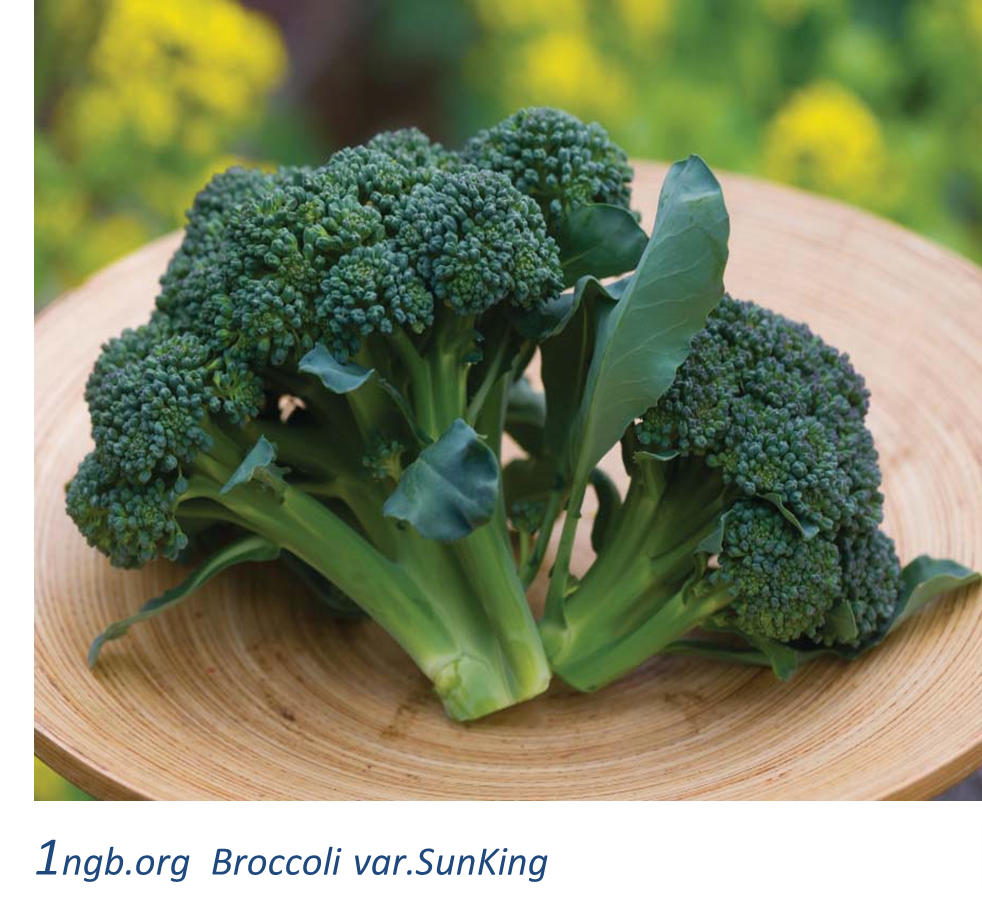
Growing Conditions
To thrive, Brassicas need fertile, well-drained soil high in organic matter. A soil test of the area prior to planting (UConn Soil Nutrient Analysis Lab) will determine if supplemental nutrients are needed and if the soil is within the required 6.0-7.5 pH range.
Members of this family should not be planted where related members have been planted within the past four growing seasons to avoid infection by pests and diseases remaining in the soil or on infected plant debris.
Seeds can be started indoors by early March for summer harvest, or by mid-June for fall harvest. Add two or three extra weeks for days-to-maturity if plants are started from seed. Generally, greenhouse-started transplants can be set out by mid-April – (about 4 weeks before the last frost date in Connecticut) - and by September for fall harvest. Greenhouse-started plants are harder to find for fall planting.
If starting seeds indoors use a sterile, soilless seedling mix. Plant seeds about 1/4 – 1/2 inch deep, moisten the material, and keep at temperatures around 70° F until germination. Bottom heat is not needed as these plants will develop at 60-65°F. Once seedlings emerge, provide direct sunlight, or use overhead lights, to prevent plants from getting leggy.
- water seedlings with a diluted low nitrogen fertilizer at sprouting and once or twice a week until the plants have 2-3 sets of leaves, then reduce watering.
- around 4-6 weeks, move the plants outside to start hardening off by gradually exposing them to more sunlight. Protect the young seedlings from wind.
For direct seeding, seeds will germinate if the soil temperature is above 45°F.
Planting Instructions
- For direct seeding, drop 3 seeds 1/2-3/4 inches deep into holes in soil that has been prepared according to soil test results.
- Water in the plants and maintain consistent moisture until germination. When plants emerge, thin to the final spacing.
- If using greenhouse transplants, dig a trench about as deep at the growth pot. Plants that form heads, such as cauliflower, should be spaced about 12-15 inches apart in rows about 24-30 inches apart.
- Fill in and firm the soil around the plant so that its final height in the trench is about at the same level as it was in the growing pot.
- A liquid starter fertilizer higher in phosphorus, such as 3-10-3, can be applied when watering in.
- Apply a row cover to protect the young plants from wind and early feeding insects.
- Plants will do well in a sunny location with some shade. They can tolerate frost but may have reduced heading if temperatures stay below 45°F.
Cultivation
Weeding
- Cultivate carefully since brassica roots are shallow.
- Use thick layers of straw or other mulch to discourage weeds and conserve moisture.
Water
- The root zones of plants in this species all need deep and regular watering to develop more flavorful and well-shaped heads. As heads develop the plants will need more frequent watering.
- Prevent roots from becoming water-logged.
Fertilizing
- Brassicas are heavy feeders. Depending on soil test results, add compost and well-aged manure at transplanting. Side dress when the plants are 4-inches tall and again in the spring or fall.
- Add 1/4 lb. of 10-10-10 per 10 ft. row fertilizer after harvesting the main head to help produce smaller side heads after the main head is removed.
Harvesting
Bok Choy: (B. rapa subsp. chinensis) is also sensitive to bolting if temperatures fluctuate outside its preferred range. Bok choy leaves can be harvested as they mature or wait for the head to mature. Flavor is best if plants are harvested when leaves are tender.
Broccoli: (B.oleracea v.italica) Harvest when the heads reach a useable size, are tight and before buds have opened. Harvest as soon as the head is mature, cutting a short stalk. Side shoots should be harvested when they reach a good size. Harvest before individual buds become obvious or buds begin to yellow, as this gives lower taste and nutritional quality. Refrigerate or process heads immediately after harvest to maintain plant quality.
Brussels Sprouts: (B. oleracea svar.gemmifera) Harvest can occur even after temperatures fall below freezing. Largest sprouts form lower on the stalk, but if the top 1-2 inches of the stalk is removed when the lowest sprouts are about 1-inch in diameter, the upper sprouts will also enlarge. Harvest when sprouts are firm, dark green and about 1-1.5 inches in size. They can be picked individually and stored in the refrigerator for 7-10 days, or when the whole stalk has matured. To harvest the whole stalk, remove the leaves and cut the stalk at the base. Store at 34-40°F and in high humidity. Best flavor is maintained the shorter the storage period but they will last 3-5 weeks under ideal conditions. Blanch and freeze soon after harvest for best quality.
Cabbage: (B. oleracea var.capitata) Harvest once heads become firm. Mature size will depend on variety and growing conditions. Reduce the potential for mature heads to split by twisting the head a quarter-to-half-turn to break part of the plant’s roots. Excess water can also cause heads to split. Cabbage can be stored at 32-45°F and above 80% humidity for several months.
Chinese cabbage: (B. rapa subsp. pekinensis) If exposed to frost or night temperatures below 50°F, these plants tend to bolt prematurely when warmer weather returns. Use a cover if freezing temperature is forecast. Harvest Chinese cabbage when heads feel firm and tight. If leaves feel loose, allow more time to develop. Cut off the head above the outside leaves.
Cauliflower: (B. oleraca var.botrytis) This vegetable can be tricky to grow. When mature, it won’t tolerate hard freezes. The round, compact head is called the “curd,” or the flowering part of the plant. It should be harvested before the flowers open or sections begin to split. Buttoning (the head stops growing after it reaches about 1-1.5 inches) can occur if the plant is stressed by either high or low temperatures or the transplant was over grown. As heads form, blanching is needed to keep the head white. When the head is 2-3 inches in diameter, gather outer leaves around the center curd and secure them with string or rubber band. Harvest 8-12 days after tying or when head is clear white and is about 6 inches in diameter.
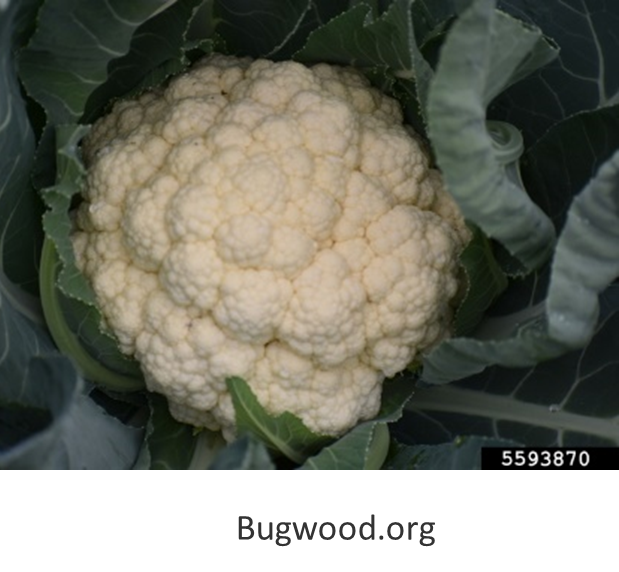
Collard and Kale: (B. oleracea subsp. acephala) The leaves of these greens can be harvested individually or as a whole plant. If some “baby” leaves are harvested, the plant will continue to produce for additional pickings. Flavor is best if leaves are harvested before hot, dry weather sets in when leaves can become tough and less flavorful. Harvest solid green and firm leaves; discard any leaves that start to yellow. Store leaves under very cold and humid conditions for 2-3 weeks for best flavor and nutrition. Grow these greens in the fall instead of the spring since colder temperatures tend to enhance the sugar content and flavor of the leaves. Follow the same process to harvest mustard greens.
Kohlrabi: (B. oleracea var. gongylodes) This bulbous plant is best harvested when it reaches 2-3 inches in width, otherwise it gets tough and bitter. Like its relatives, it grows best in cooler weather and with adequate moisture. Splitting is possible if harvest is delayed too long. The bulbs can be stored for months if kept in very cold and humid conditions.
Rutabagas: (B. napobrassica) While these root plants are often confused with turnips, rutabagas are harder, denser and sweeter than turnips. Flavor is improved if they stay in the soil until after a hard frost. Harvest them when they are about 3-4 inches in diameter and the top edges (shoulders) show above the soil. The tops can also be harvested. Both the yellow root and the greens should be cooked. Use a spading fork to loosen the soil around the root for easier harvest. Rutabagas can be stored in the ground for several weeks. If they are stored for more than 1-2 weeks in the refrigerator they will rapidly lose their moisture and they may begin to sprout roots.
Turnips: (B. rapa subsp.rapa) Harvest when the above-ground shoulders are about 2 inches in diameter. If they become larger before harvesting they become tough, woody and bitter. They taste best while young, and can be cooked, pickled or eaten raw. Remove the green tops from the bulb when harvested, and store the greens and bulbs separately in very cold and humid conditions. If they are stored for more than 1-2 weeks in the refrigerator they will rapidly lose their moisture, and quality is reduced.
Common Insect Pests
Many brassica pests spend their first generation on wild mustard plants and will move into brassicas crops by the second generation. Remove mustard plants to encourage cabbage pests to move on.
Imported cabbageworm - aka white cabbage butterfly - (Pieris rapae)
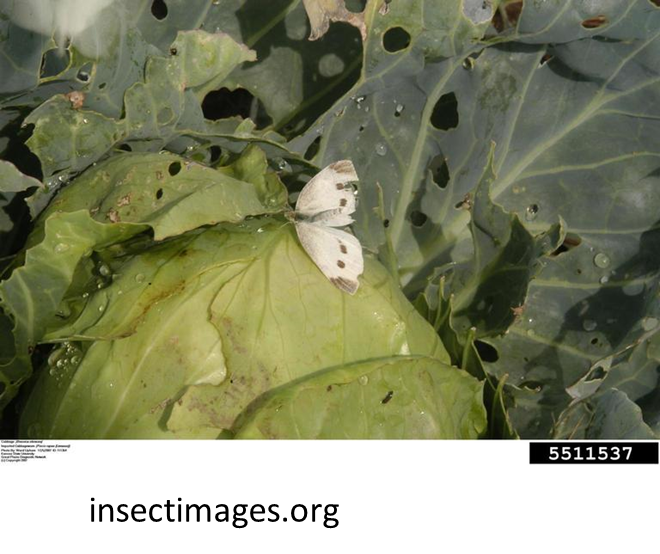
This is the most common caterpillar in gardens. It initially makes small holes in leaves. Holes eventually enlarge until the whole leaf in eaten, leaving only the midrib. Older, larger caterpillars cause the most damage to brassica crops. Adults appear in early May and remain for the entire growing season, producing 3-5 overlapping generations. Eliminate larvae when small to avoid serious plant damage. Pupae and chrysalis overwinter in plant debris.
- eggs are white to pale yellow, oblong, laid singly and standing upright on the upper and lower surfaces of leaves.
- larvae are 1-1/2 inches long, slightly fuzzy green with yellow stripes along the sides and mid-back. They move slowly, initially produce small feeding holes which enlarge until nothing is left except the mid-rib. Large, dark green droppings are left on and under the affected plant.
- pupae have a unique chrysalis shape with 2 “arms” sticking out the sides and one seam running down the center back. The chrysalis usually matches its yellow, green or brown background, and is attached to a food source or nearby plant by a thin thread.
- adults have a 2-inch wingspan, white forewings with a black outline and a yellow underside. Females’ wings have 2-3 black spots and males have one spot. Females can lay 300-400 eggs during a 3-6 week life cycle. Adults are active flyers but only feed on nectar; they do not damage plants.

Prevention
- Rotate out of planting brassica crops in an infected area over a 2-4 year period.
- Use seed that is certified as disease free, and/or consider hot water seed treatment for seeds that are known to have originated from diseased plants. (http://plant.lab.uconn.edu/hwst)
- Do not work in beds when plants are wet.
- Use drip irrigation to avoid excess water on leaf surfaces.
- Adequately space plants to promote good air circulation and to encourage drying.
- Control weeds in the planted area as they may serve as alternative hosts of the pathogen and promote bacterial spread.
- Remove and destroy or bury any infected crops after harvest.
Black leg (Phoma linga)
Black leg is a fungal disease that causes ashy-to-black circular spots containing tiny black fruiting bodies on leaves or stems of brassica plants. Lesions appear along the stem, lengthen and turn brown with a purplish border. They eventually girdle and blacken the stem, and extend into the soil and into the plant’s roots. These effects cause stunting, wilting, and eventual plant death. Blackleg is often introduced from infected seeds, but can also be introduced by transplants and field conditions. Wet, humid conditions and mild temperatures promote spread of the disease. Fall and spring-grown plants are more susceptible to black leg due to favorable weather conditions. Spores can be wind-carried over long distances, and survive for long periods on soil, plant debris, and seed.
Fungal spots on stem and leaves
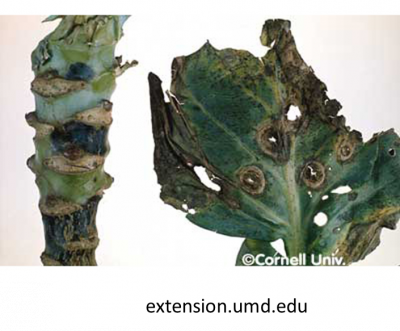
Prevention
- Rotate out of planting brassicas in the same space for 2-4 years.
- Use certified disease-free seed or transplants. Consider hot water seed treatment for seeds that are known to have originated from diseased plants. (http://plant.lab.uconn.edu/hwst)
- Avoid working with wet plants.
- Adequately space plants for good air circulation and to encourage drying.
- Control weeds that may promote spread of fungal spores in the planted area.
- Remove and destroy or bury any infected crops after harvest. Spores of P. linga do not survive on buried plant residue, only on those that remain on the surface.
Downy mildew (Hyaloperonospora parasitica)
Downy mildew is a disease caused by a fungal-like organism. Small, angular lesions develop on leaves and flowers. As lesions enlarge, they turn yellow-orange in patches on the upper leaf surface with a greyish powder on the undersides. Heavily infected areas turn gray-purple, and take on a fuzzy, downy appearance. The leaf may look papery as well. The pathogen is spread by wind and water. Infection occurs in wet, cool weather. Downy mildew is most important on brassica seedlings but can occur on older plants as well. The disease stresses plants and may make them susceptible to other diseases. Continuous days of cool day and night temperatures provide conditions for disease development.

Prevention
- Select downy mildew-resistant varieties of seed or transplants.
- Provide space for good air circulation and avoid planting in wet or poorly drained areas.
- Use drip irrigation rather than overhead watering, and water early in the day instead of evening so plants have time to dry out.
- Rotate out of brassicas for at least 4 years.
- Remove infected leaves or whole plants to discourage disease spread.
- Remove remaining plant material after harvest by disposing of it in the trash.
Turnip mosaic virus (TuMV)
TuMV is the most important and widespread virus affecting brassica plants. The virus is transmitted by several species of aphids, which acquire the virus by inserting their needle-like stylet mouth part into the leaf as they feed. Aphids can become infective and transmit the virus to healthy plants in a matter of seconds. Infected plants exhibit classic mosaic symptoms, which include light and dark green patches on either side of major veins, rugosity (rough leaf texture), chlorotic patches, and puckering. Plants may look stunted, chlorotic, or necrotic as infection progresses.
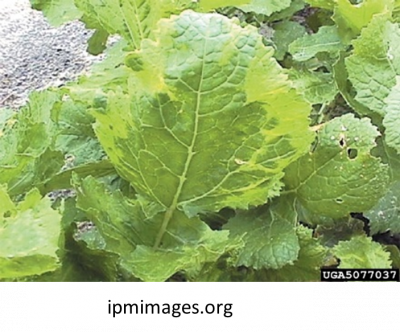
Prevention
- Choose varieties known to be resistant to TuMV.
- Once planted, check transplants frequently for evidence or initial symptoms of mosaic.
- Avoid transplants that show signs of the virus.
- Control of TuMV is difficult. Once infected, plants cannot be cured. Remove and dispose of all infested plant material. Affected plants are not marketable. The plant, its leaves and any debris should be burned.
- Spraying plants with mineral oil may deter aphid feeding, which can in turn help limit the spread of the virus. However, most insecticides are of little or no value because aphids can spread the virus so quickly.
For pesticide information or other questions please call toll free: 877-486-6271.
Revised by UConn Home and Garden Education Center 2020.
Issued in furtherance of Cooperative Extension work, Acts of May 8 and June 30, 1914, in cooperation with the U.S. Department of Agriculture, the Dean of the College, Cooperative Extension System, University of Connecticut, Storrs. The Connecticut Cooperative Extension System is an equal opportunity employer and program provider. To file a complaint of discrimination, write USDA, Director, Office of Civil Rights, Room 326-W, Whitten Building, Stop Code 9410, 1400 Independence Avenue, SW, Washington, DC 20250-9410 or call (202) 720-5964